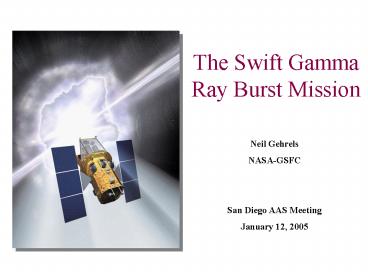The Swift Gamma Ray Burst Mission - PowerPoint PPT Presentation
Title:
The Swift Gamma Ray Burst Mission
Description:
The Swift Gamma Ray Burst Mission Neil Gehrels NASA-GSFC San Diego AAS Meeting January 12, 2005 Motivations for Swift Multiwavelength observations on all time scales ... – PowerPoint PPT presentation
Number of Views:134
Avg rating:3.0/5.0
Title: The Swift Gamma Ray Burst Mission
1
The Swift Gamma Ray Burst Mission
Neil Gehrels NASA-GSFC San Diego AAS
Meeting January 12, 2005
2
Swift Papers and Posters at AAS Meeting
Talks - Wednesday 1000 am Town
Country116.01 Gehrels Swift Science Early
Results116.02 Nousek Swift Instruments
OpsTalks - Thursday 1000 am Pacific Salon
1160.01 Barthelmy BAT Instrument160.02 Burrows
XRT Instrument160.03 Roming UVOT
InstrumentPosters - Wednesday115.01 Gronwall U
VOT On-orbit Calibration115.02 Hullinger BAT
Spectral Response115.03 Ivanushkina UVOT
Gemini Studies of Dark GRBs
3
NASA MIDEX Mission selected in 1999Primary
science is to study gamma-ray bursts throughout
the UniverseInternational hardware
participation from UK and ItalyLaunch on
November 20, 2004
4
Motivations for Swift
Black Hole Birth Ultrarelativistic
Outflows Early Universe Probes
5
Swift Designed to Answer GRB Key Questions
What is the nature of subclasses?
What causes GRBs?
What can GRBs tell us about the early universe?
What physics can be learned about BH formation
and ultra-relativistic outflows?
6
Swift Instruments
Instruments
- Burst Alert Telescope (BAT)
- New CdZnTe detectors
- Most sensitive gamma-ray
imager ever - X-Ray Telescope (XRT)
- Arcsecond GRB positions
- CCD spectroscopy
- UV/Optical Telescope (UVOT)
- Sub-arcsec positions
- Grism spectroscopy
- 24th mag sensitivity (1000 sec)
- Finding chart for other observers
- Autonomous re-pointing, 20 - 75 s
- Onboard and ground triggers
Spacecraft
7
Mission Capabilities
BAT
- Multiwavelength observations on all time scales
- gt100 GRBs per year of all types
- BAT sensitivity 2 - 5 time better than BATSE
- Arcsec positions counterparts for 100s GRBs
- Rapid GRB notifications via GCN
- Identification of host galaxies offsets
- X-ray and UV/optical spectroscopy
- Upload capability to slew to GRB and transients
detected by other observatories
XRT
UVOT
8
Swift Science - Supernova Connection
- Supernova-GRB connection
- Connections between SNe Ic and GRB are emerging.
- Swift's rapid subarcsec positions and lightcurve
monitoring will allow SN searches on 100's GRBs.
- Questions addressed What fraction and
what kinds of GRBs have underlying SN? What
fraction and what kinds of SN have accompanying
GRBs?
SN1998bw - GRB 980425
GRB 980326
9
Swift Science - Classes of GRBs
- Swift sensitive to
- Normal l o n g GRBs
- Short GRBs
- X-Ray Flashes R
- Weak GRBs
- U l t r a - l o o o o n g GRBs
- GRBs subclasses - example short GRBs
- Not understood. No counterparts detected.
Appears to be a separate class. - Non-detection of GRB 020531 indicates afterglow
is weak or rapidly declining. - Swift will perform rapid follow-up observations
of 100 short GRBs
10
Lamb Reichart (2000)
Swift Science - Early Universe
- Early Universe
- GRBs are the brightest events in universe.
- Afterglow is detectable to z15 by Swift (3 to15
per year at zgt10) - Topics addressed
- Epoch of first stars (GRB may be unique probe of
Pop III stars) - Star formation history
- Re-ionization of IGM
- Metallicity history
- Dust and gas content of early galaxies
- Large-scale structure of universe
11
Swift Observatoryin GoddardClean Room
12
Arrival at KSC
13
Swift Observatoryat KSC
14
(No Transcript)
15
(No Transcript)
16
(No Transcript)
17
Swift Launch video
18
Swift Activation
- Following launch, 1.5 months activation and 3
months verification. Observatory will be fully
operational on April 5, 2005 - Public data and GI program start after
verification phase. - Any GRB reliably detected during verification
will be distributed on GCN (non-realtime, after
BAT-team checking) - 35 proposals selected for Cycle 1 of Guest
Investigator program. Cycle 2 proposals due July
2005. - Swift follow-up team coordinated by K. Hurley
- EPO team coordinated by L. Cominsky
19
Scientific Findings To Date
- 9 GRBs detected since Dec. 17
- Large GRB detected on Dec. 19
- (GRB 041219)
- XRT pointed at GRB 041223 via ground command at
4.5 hours. Afterglow detected. - Giant flare detected from
- soft gamma repeater SGR 1806-20 on Dec. 27
- BAT is performing sensitive monitoring of hard
x-ray sky
20
Light Curves of BAT GRBs
detected by other gamma-ray instrument
slewed to and imaged by XRT detected by
ground-based optical/IR
21
GRB 041219
- Long duration GRB lasting 500 s
- Fluence of 10-4 erg cm-2
- Fluence in top 1 of CGRO/BATSE bursts
- Duration in top 2 of CGRO BATSE bursts
- Imaged by INTEGRAL Swift
- IR fast-fading counterpart ("flash") discovered
at early time - Real-time (RAPTOR) optical detection
- Radio counterpart
- Campaign underway to determine host and redshift
22
GRB 041223 First XRT GRB Afterglow
23
GRB 041223 Decay Lightcurve
24
Giant Flare from SGR 1806-20
- SGRs are galactic neutron stars with huge
magnetic fields (1015 G) that have occasional
active periods and outbursts. - SGR 1806-20 discovered in 1986. Four known SGRs
- Detected on Dec. 27, 2004 by all non-occulted
gamma-ray detectors in space - Huge main peak lasting 0.5 sec followed by 400
sec of pulsations - Estimate (Boggs et al. GCN 2936) puts fluence
greater than 0.1 erg cm-2, 1-2 orders of
magnitude greater than SGR 190014 1998 and SGR
0526-66 1979 flares. - Radio transient detected. Slightly extended
source. Polarization detected.
25
(No Transcript)
26
BAT Detection of 7.6 sec Pulsations
27
Swift Non-GRB Capabilities
Hard x-ray survey of sky Transient
monitoring Multiwavelength response to
transients detected by others
28
Swift Team
GSFC































